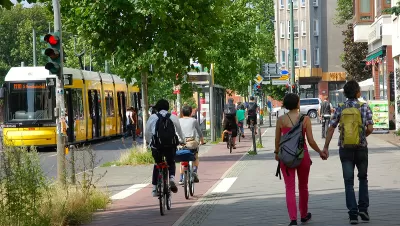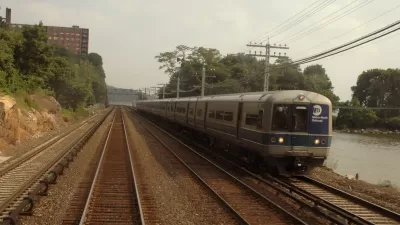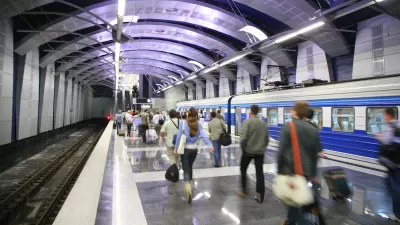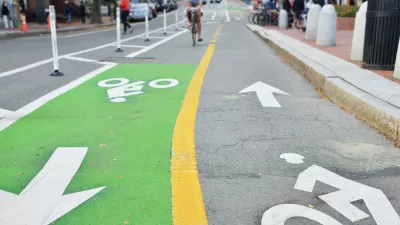An efficient and equitable transport system must be diverse to serve diverse travel demands. Planners need better tools to quantify and communicate the benefits of walking, cycling and public transit to sometimes skeptical decision makers.

President-elect Donald Trump has selected Elaine Chao to be transportation secretary. It is a clever selection: she is both a woman and an ethnic minority, and a politically experienced Washington insider (she previously served as Secretary of Labor and is married to Senate Majority Leader Mitch McConnell).
She is also politically very conservative. Chao is a fellow at the Heritage Foundation, a "free market" policy institute that advocates automobile-oriented transportation planning. This represents the old transportation planning paradigm, which evaluates transportation system performance based primarily on motor vehicle travel conditions, using indicators such as roadway level-of-service, average traffic speeds and traffic congestion delay, and considers walking, cycling and public transit to be inferior modes, to be avoided as much as possible. This perspective favors automobile-oriented transportation investments, such as highway expansions and parking subsidies, and considers expenditures on active and public transport to be wasteful and unfair. Reflecting this paradigm, the Heritage Foundation's Tyransportation Policy Recommendations would eliminate federal funding for anything but highway projects; it would end all federal support for public transportation, congestion reduction and air quality programs, transportation alternatives (which include walking and cycling improvements), partnerships on livability programs, ferry services, the federal lands access programs, scenic byways, and education programs.
In contrast, a new planning paradigm recognizes that an efficient and equitable transportation system must be diverse in order to respond to diverse demands. Many trips are best made by walking, cycling, or pubic transit, and many people cannot or should not drive. For example, it is inefficient if a lack of motorized transport forces people to walk long distances with heavy loads, but it is also inefficient if poor walking and cycling conditions force people to drive to local destinations that could easily be made by non-motorized modes, or if inadequate public transit services leads to high automobile modes shares on major urban corridors, leading to congestion and high costs. Current demographic and economic trends, including an aging population, changing consumer preferences, and increased health and environmental concerns, are increasing demand for walking, cycling, and public transportation.
Fortunately, the basic principles of multi-modalism are now well established in the planning world, as indicated by the good work of organizations such as the Institute of Transportation Engineers to develop Complete Streets policies, and leadership by many regional planning associations and state departments of transportation. I am therefore confident that, overall, the momentum will continue.
Despite this progress, the new administration is likely to be skeptical of investments in walking, cycling, and public transit, and efforts to integrate transportation and land use planning. We will face a higher burden of proof that such programs and projects are economically justified. As a result, planners will need to do a better job of defining and communicating the value of multi-modalism, and develop better tools for incorporating these values into the transportation planning process.
There is both good and bad news. The good news is that a diverse transportation system really does provide many important benefits, including direct benefits to the people who walk, bicycle, and use public transport, and indirect benefits to people and business who do not currently use those modes but enjoy reduced traffic and parking congestion, reduced chauffeuring burdens, increased safety, and other benefits. There is also good news from the recent election: public transit referenda had high success rates, including in politically conservative regions such as Atlanta, Georgia, indicating broad support for transportation diversity.
The bad news is that conventional transportation economic evaluation practices, such as benefit-cost analyses of transportation policies and projects, tend to overlooks and undervalue many of these benefits, including economic impacts such as parking cost savings, and emerging planning goals such as improved public fitness and health. As a result, conventional evaluation is biased in favor of automobile transportation and sprawled land use development, and significantly undervalues improvements to walking, cycling and public transit services, and policies that create more accessible (compact, mixed and connected) land use development.
Scope of Impacts Considered In Conventional Transport Evaluations
|
Usually Considered |
Often Overlooked |
|
Government expenditures on facilities and services Travel speed (congestion delays) Vehicle operating costs (fuel, tolls, tire wear) Per-mile crash risk Roadway costs Road construction environmental impacts |
User comfort and convenience (e.g., transit passenger comfort) Consumer savings and affordability (savings to low-income households) Parking congestion and costs Mobility for non-drivers, social equity impacts Per capita crash risk Public fitness and health Barrier effect (delay to pedestrians and cyclists) Economic development impacts Indirect environmental impacts Strategic land use impacts (smart growth) |
Conventional transportation planning tends to focus on a limited set of impacts.
What should planners do? To achieve more optimal transportation planning outcomes we will need to do a better job of identifying, measuring, and communicating the full benefits of creating more diverse transportation systems and more accessible communities. We need better evaluation tools to help predict and quantify these impacts in order to build a solid business case for pedestrian, cycling, public transit, complete streets, transportation demand management, and Smart Growth programs.
Of course, different stakeholders have different priorities. It is important to start with comprehensive information on the total benefits of these investments, but tailor discussions to individual audiences: businesses want to hear about traffic and parking congestion reductions of reduced automobile trips, public health professionals need to hear about the safety and health benefits of reduced driving and more active transport, community groups care about increased affordability and improved mobility for non-drivers, and environmentalists want to know about energy savings and emission reductions. There is something for everybody, but its up to us to quantify and communicate these benefits.
This is not a new issue. Proposals to invest more in active and public transit have always faced more scrutiny than road and parking facility investments, which often have dedicated funding and standard evaluation practices, but the need for comprehensive evaluation is greater than ever if we are to continue the progress of the last decade in creating truly efficient and equitable transportation systems.
I've listed some existing multi-modal evaluation tools. Have I overlooked any? What do you think is needed to help planners defend transportation diversity to sometimes skeptical decision-makers?
Existing Resources
Gigi Cooper and Jennifer Danziger (2016), “Evaluating Return: A Benefit Calculator for Active Transportation Projects,” ITE Journal, Vol. 86, No. 9, pp. 25-29.
CUTA (2010), The Economic Impact of Transit Investment: A National Survey, Canadian Urban Transportation.
EMBARQ (2013), Social, Environmental And Economic Impacts Of BRT Systems: Bus Rapid Transit Case Studies from Around the World, EMBARQ.
EVIDENCE (2014), How Urban Transport Projects are Appraised: Current Practice in the EU, by the Wuppertal Institute for Climate, Environment and Energy for the EVIDENCE Project: Economic Benefits of Sustainable Transport
Ranjit Godavarthy, Jeremy Mattson and Elvis Ndembe (2014), Cost-Benefit Analysis of Rural and Small Urban Transit, Upper Great Plains Transportation Institute, North Dakota State University, for the U.S. Department of Transportation.
Todd Litman (2008), Introduction to Multi-Modal Transport Planning, Victoria Transport Policy Institute.
Todd Litman (2010), Raise My Taxes, Please! Evaluating Household Savings From High Quality Public Transit Service, Victoria Transport Policy Institute.
Todd Litman (2011), Evaluating Active Transport Benefits and Costs: Guide to Valuing Walking and Cycling Improvements and Encouragement Programs, Victoria Transport Policy Institute.
Todd Litman (2015), Evaluating Public Transit Benefits and Costs, Victoria Transport Policy Institute.
NZTA (2010), Economic Evaluation Manual, New Zealand Transport Agency.
Christopher Porter, Jonathan Lee, Taylor Dennerlein and Paula Dowell (2015), Selected Indirect Benefits Of State Investment In Public Transportation, Research Results Digest 393, NCHRP Project 20-65, Task 52, National Cooperative Highway Research Program.
TIDE (2013), Impact Assessment Handbook: Practitioners’ Handbook For Cost Benefit And Impact Analysis Of Innovative Urban Transport Measures, TIDE (Transport Innovation Deployment for Europe) Project (www.tide-innovation.eu).
UKDfT (2013), New Approach to Transport Appraisal (NATA), Department for Transport.
USDOT (2016), 2016 TIGER Benefit-Cost Analysis Guidance, Office of Infrastructure Finance and Innovation, US Department of Transportation (www.ops.fhwa.dot.gov).
Ian Wallis, A. Lawrence and Neil Douglas (2013), Economic Appraisal Of Public Transport Service Enhancements, Report 533, New Zealand Transport Agency.

Alabama: Trump Terminates Settlements for Black Communities Harmed By Raw Sewage
Trump deemed the landmark civil rights agreement “illegal DEI and environmental justice policy.”

Planetizen Federal Action Tracker
A weekly monitor of how Trump’s orders and actions are impacting planners and planning in America.

The 120 Year Old Tiny Home Villages That Sheltered San Francisco’s Earthquake Refugees
More than a century ago, San Francisco mobilized to house thousands of residents displaced by the 1906 earthquake. Could their strategy offer a model for the present?

Ken Jennings Launches Transit Web Series
The Jeopardy champ wants you to ride public transit.

BLM To Rescind Public Lands Rule
The change will downgrade conservation, once again putting federal land at risk for mining and other extractive uses.

Indy Neighborhood Group Builds Temporary Multi-Use Path
Community members, aided in part by funding from the city, repurposed a vehicle lane to create a protected bike and pedestrian path for the summer season.
Urban Design for Planners 1: Software Tools
This six-course series explores essential urban design concepts using open source software and equips planners with the tools they need to participate fully in the urban design process.
Planning for Universal Design
Learn the tools for implementing Universal Design in planning regulations.
Clanton & Associates, Inc.
Jessamine County Fiscal Court
Institute for Housing and Urban Development Studies (IHS)
City of Grandview
Harvard GSD Executive Education
Toledo-Lucas County Plan Commissions
Salt Lake City
NYU Wagner Graduate School of Public Service






























